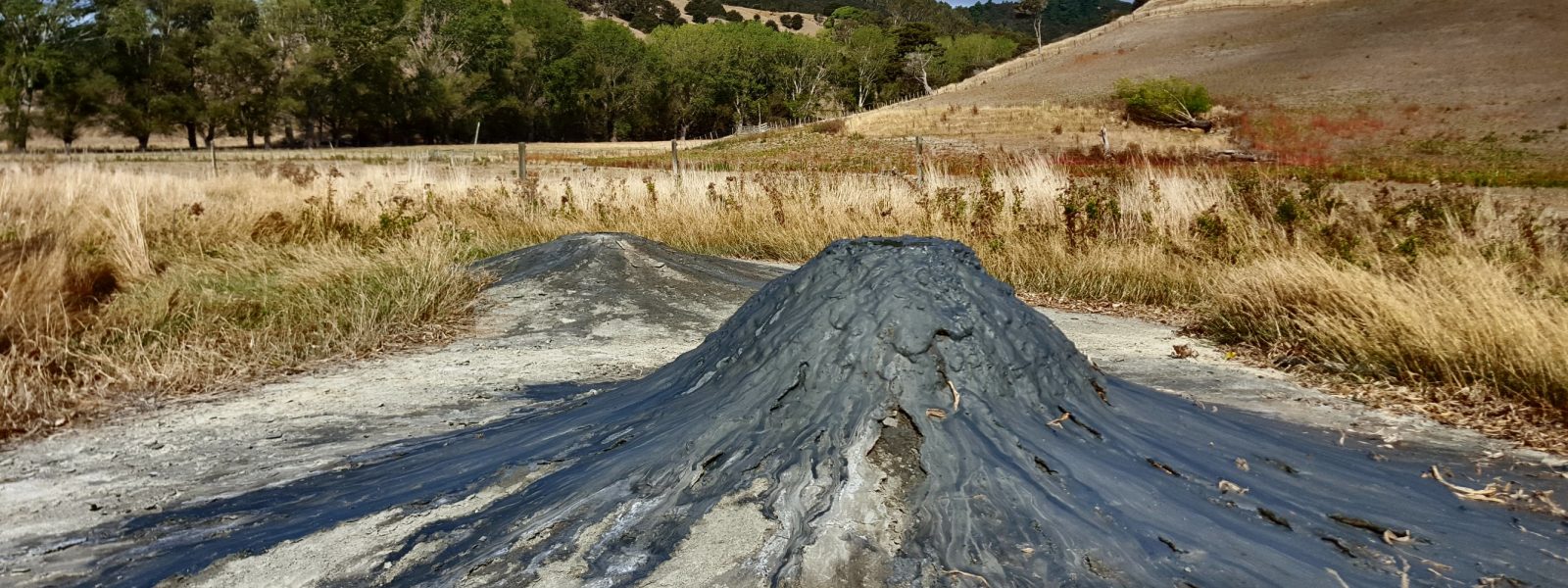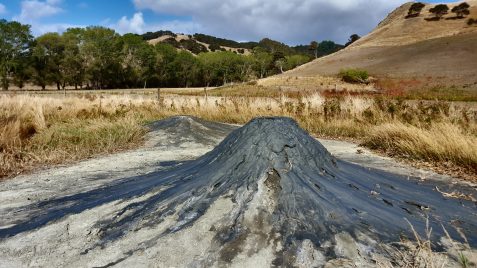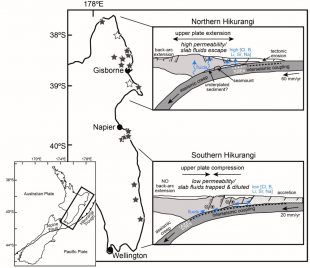Jaime D. Barnes (UT Austin), Jeffrey Cullen (UT Austin), Shaun Barker (Univ. of Waikato), Samuele Agostini (Istituto di Geoscienze e Georisorse), Sarah Penniston-Dorland (Univ. of Maryland), John C. Lassiter (UT Austin), Andreas Klügel (Univ. of Bremen), Laura Wallace (UT Austin & GNS Science), Wolfgang Bach (Univ. of Bremen)
Much work has focused on defining the elemental concentration and isotopic composition of subduction zone inputs (e.g., sediments, altered oceanic crust, serpentinites), as well as outputs (e.g., volcanic gases and melt inclusions), in order to assess global cycling of volatiles. However, with most work focused on outputs from the volcanic front, poor constraints on the geochemistry of forearc outputs hamper global volatile flux calculations. In fact, most global flux calculations ignore contributions from the forearc because their outputs and the subducted sources contributing to the fore-arc outputs are poorly constrained (e.g., Barnes et al., 2018). The Hikurangi margin of New Zealand has a largely subaerial forearc which hosts numerous fore-arc seeps and springs (Fig. 1). This portion of the forearc is typically submerged beneath the ocean at most other subduction zones. Easy access to fore-arc springs along the margin allows for quantification of volatile flux and sources through the shallow portion of the subduction system (< 50 km).
In addition, there are dramatic along strike variations in subduction parameters along the length of the Hikurangi margin (Fig. 1). The northern portion of the margin has a thin layer of sediments (~ 1 km thick) and many seamounts on the subducting plate, a steep taper angle (7º to 10º) for the accretionary wedge, and shallow (< 15 km depth) aseismic creep. In marked contrast, the southern portion of the margin has a thick (3 to 6 km thick) package of sediments on the incoming plate, low taper angle (4º to 6º), and undergoes stick-slip behavior (e.g., Wallace et al., 2009). Interestingly, previous studies have documented an overall decrease in the Cl, B, Br, Na, and Sr concentrations in fore-arc spring waters from the north to the south (Giggenbach et al., 1995; Reyes et al., 2010). These observations raise numerous questions, such as: the amount of slab-derived fluid component to the springs; whether fluid sources vary along the length of the margin; and particularly whether any chemical variations in the spring fluids record dehydration metamorphic reactions that may be linked to changes in slip behavior along the margin. In order to address these questions, we have sampled fluids from sixteen cold and two thermal springs from along the Hikurangi margin and analyzed them for their cation and anion concentrations, as well as their B, Li, and Cl stable isotope compositions. Because Li, Cl, and B are highly fluid-mobile elements, their incompatibility limits modification by fluid-rock interaction making them excellent tracers of fluid source.
Data show that Cl, Br, I, Sr, B, Li, and Na concentrations are high in the forearc springs, consistent with previous studies. Most of these elements show a general decrease in concentration from north to south, a high in the central part of the margin, and limited variability through time. Despite the dramatic change in concentration along the margin, there is no corresponding trend in isotopic composition. Cl and B isotope compositions are remarkably consistent along the margin, suggesting fluids dominated by seawater and sedimentary pore fluids. Lithium isotope compositions are highly variable, suggesting fluids sourced from seawater and locally modified by interaction with host rock. High Br/Cl and I/Cl weight ratios also support a dominant seawater and pore fluid source.
The decrease in the absolute volatile concentrations along the margin is therefore not due to changes in subduction parameters (e.g., convergence rate, sediment subduction) altering the fluid source along the strike. In addition, the shift in seismic behavior along the margin is not linked to a change in fluid source within the forearc region. Instead, we hypothesize that the shift in volatile concentrations along the margin is controlled by fluid flux through the upper plate, due to increasing upper plate permeability from south to north. In the northern portion of the margin, the upper plate is undergoing extension, whereas in the southern portion, the upper plate is undergoing transpression (Fig. 1) (Wallace et al., 2004). The extension in the northern section of the margin could increase the permeability of the upper plate allowing for fluid loss along normal faults, and possibly lower fluid pressure within the forearc and near the interface. In contrast, the transpressional regime in the south could decrease the permeability of the upper plate, trapping fluids and increasing fluid pressure in the upper plate (Fagereng and Ellis, 2009). This model of changing permeability from north to south explains the decrease in volatile concentrations in spring fluids along strike. In the south, trapping of expelled seawater and pore fluids in the upper plate will allow the fluids to become diluted by meteoric groundwater, but their isotopic compositions will remain unchanged. Whereas in the north, the seawater and pore fluids will be able to pass through the upper plate with less dilution by groundwater. Seismic tomographic and attenuation data also suggest that more fluids are present in the northern and central portions of the upper plate of the Hikurangi subduction zone, compared to the south (Eberhart-Phillips et al., 2017; Eberhart-Phillips et al., 2005; Eberhart-Phillips et al., 2008). Springs with the highest concentrations of volatile elements are located in regions with some of the highest seismic attenuation (which can be interpreted as abundant inter-connected fluids). It is possible that the fluid pressure conditions in the upper plate may play an important role in seismic behavior along the Hikurangi margin. Higher fluid pressures in the south suppress the transition from brittle to viscous deformation, resulting in a deeper brittle-viscous transition and the occurrence of stick-slip behavior to greater depths (Fagereng and Ellis, 2009; Wallace et al., 2012). Greater structural permeability in the northern Hikurangi margin may allow fluids to bleed off, without building significant overpressures in the forearc — this could lead to a comparatively shallower brittle to viscous transition. This work highlights the role of the upper plate tectonics and permeability in controlling the flow of fluid through the forearc and the geochemical consequences on shallow outputs through the subduction system. ■



